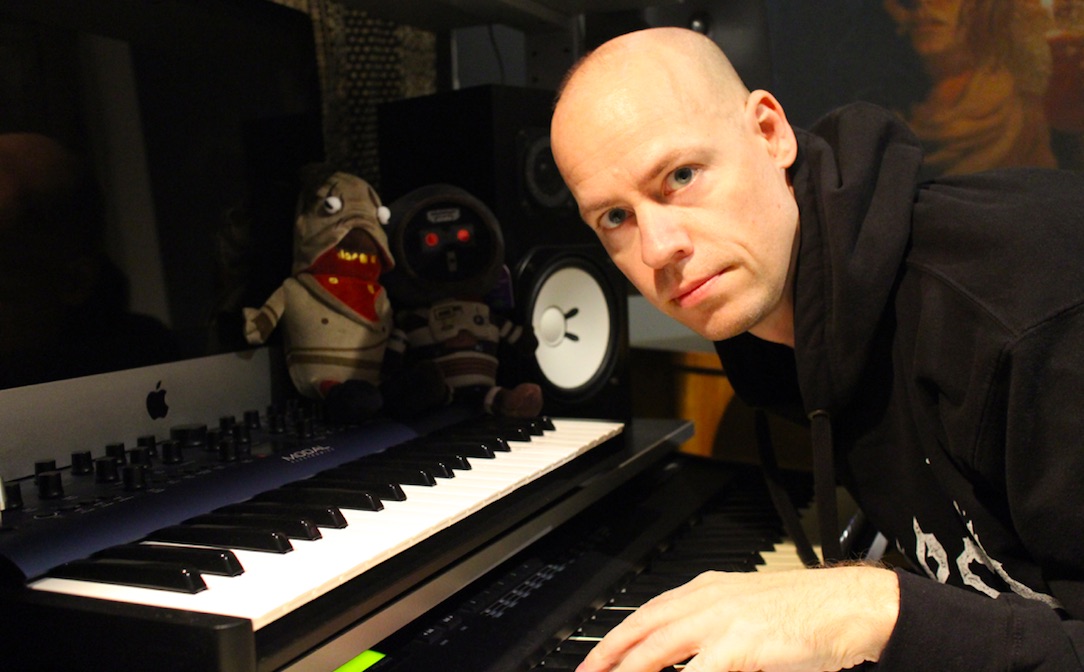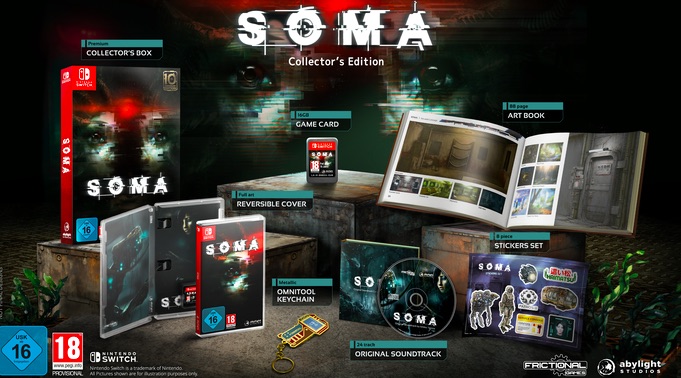In commemoration of the tenth anniversary of the game's release, Abylight Studios has launched a crowdfunding campaign on Kickstarter for the physical collector's edition for Nintendo Switch consoles. Mixing stealth, exploration and puzzle gameplay, the eerie science fiction scenario unfolds in an abandoned underwater research facility.
The soundtrack by Finnish composer Mikko Tarmia will receive a compact disc release, included with SOMA Collector's Edition. Abylight provides details in their backer updates on the composer's use of various synthesizers, processed through effects units, adding delay and reverb.
Here, the musician offers creative insights into his work composing the soundtrack for Frictional Games' iconic survival horror title.
 Studio selfie by Mikko Tarmia
Studio selfie by Mikko Tarmia
Collaborating with Frictional - Penumbra's HPL game engine
With a background in both classical and electronic music, Mikko Tarmia began composing for videogames in 2002, working as a freelancer at CodeBlender Software. The company based in the United States was developing games for Mac operating systems.
"After a few projects, from out of the blue, I received an email from [CodeBlender] audio designer, Jens Nilsson," Tarmia recalls, "and he asked me if I could join a project they were doing with his friend. It was a tech demo called 'Penumbra.'"
Frictional's experimental build was intended to demonstrate a working product powered by the studio's custom HPL game engine. The small-scale collaboration led to Tarmia's involvement in the full-length Penumbra: Overture, and two subsequent installments in the Penumbra trilogy. In the process, Tarmia's compositional style became an integral component of Frictional's first-person horror aesthetic.
Penumbra: Overture - Ambient track from the survival horror game developed by Frictional Games
Amnesia: The Dark Descent launched in 2010, requiring a relatively small-scale soundtrack, and was awarded the Excellence in Audio prize at the 2011 Independent Games Festival. The composer mentions, reflecting on the critical success of the music score, "I think Amnesia: The Dark Descent is still my best work when it comes to coherency."
Tarmia recalls, "After Amnesia, [Frictional] kind of decided they weren't going for a horror game. They wanted to do an adventure game, which was happening in the bottom of the ocean. I saw some pictures first; I think it was 2011. I'm not sure how long they were developing the game before that—perhaps for a year."
SOMA would require a more ambitious music score, entailing new challenges in music composition and sound design, while some aspects of the process remained the same. The composer began by identifying appropriate instrumentation and tone, leading to the composition of central themes early on in development:
"Each character has their theme. That was the case in Amnesia, as well... I usually want to have some kind of working material for the game. I can use the theme to get a more coherent soundtrack, using parts of themes or motifs in different spots."
Amnesia OST: Excerpt 01, via SoundCloud
Developing SOMA - Composition & Sound Design
While SOMA was initially intended to be an adventure game, over a year into production Frictional's design team concluded that exploring an entirely different genre of storytelling was limiting the project's creative potential—There needed to be horror.
The storyline of SOMA found a renewed purpose in grappling with philosophical concepts associated with identity and consciousness. This shift in tone brought to the fore the anxiety-provoking question of what makes us human.
SOMA introduces the player to protagonist Simon Jarret, as he sleeps in his studio apartment in Toronto. Simon is tormented by recurring memories of a near-fatal car crash that injured his brain and killed his passenger. Upon waking, the player can explore Simon's apartment in a first-person perspective, opening the curtains and removing items from the shelves.
This tutorial sequence is completed by locating the tracer fluid needed for Simon's brain scan, and directing the protagonist to his doctor's appointment by subway.
SOMA: Behind the Music, via Frictional Games
Audio designer Samuel Justice provided Tarmia with video footage of each location requiring music, informing the tense, immersive atmosphere of the score.
"The soundscapes I did are in sort of a border line of what sound designers do, blending together with environmental sounds," the composer explains, "I also did some of the 'musical' sound effects—small stingers and such."
Much of the sound design utilized u-he synthesizer plugins—primarily Zebra, Bazille, and Hive software instruments. "I also had Waldorf Q and a modular synthesizer, among other music gear," Tarmia says, "but working with software is so much faster and that's what I used most of the time."
In September, the Windows edition of SOMA commemorated ten years of publication
According to creative director Thomas Grip, over the span of five years SOMA's dev team almost tripled in size. In total, Frictional's audio team assembled a library of 18,000 sound effects files, outside of voiceovers and music score.
The dedication to realistic sound design extended to a room size system, implemented in collaboration with foley artist Tapio Liukkonen. Hundreds of different footstep sounds are associated with corresponding locations according to the size and acoustics of the space, conveying a maximal sense of realistic immersion.
"I used perhaps 70%-80% of my composing time crafting sounds," Tarmia says of his contribution to SOMA's broad array of audio:
"I'm not the type of guy who wants to use presets or something that somebody else has created before. I make my own sounds for music, and that's very time-consuming. The encounters with monsters—the screeching or scary sounds—has a big palette of, I don't know, hundreds of sounds. There are no limits when you're doing synthesized music and sounds."
SOMA Physical Collector’s Edition on Kickstarter
SOMA's 10th Anniversary - The Collector's Edition Soundtrack
SOMA Original Soundtrack premiered on October 25th of 2015. The composer decided that the track order should not be determined strictly by the chronology of the events encountered in-game. "It's more like a listening experience," he explains.
"Because it's not only the story I'm thinking about—it's the pacing of the tracks. And I don't want to have two similar tracks next to each other, so that's where it has a different order."
The track "Ark" the composer describes as dramatizing "the last hope for humankind:"
"[Ark] is a progressive track wherein each round new instruments are added and it gets more massive towards the end. Someone has mentioned it sounds quite similar to Hans Zimmer's 'Time' from Inception, and I agree, there are similarities. The end credits song 'Alone' has the same idea but it's not that big in scale. It's more intimate."
SOMA Original Soundtrack on Spotify
SOMA for Nintendo Switch 2 incorporates improved resolution, with a more stable refresh rate, better textures and reduced loading times, while also benefiting from the handheld console's screen, offering greater sharpness.
Frictional Games' SOMA is also available for PlayStation 4 and Xbox One consoles, along with Windows, Mac and Linux through Steam, GOG.com, and the Epic Games Store.
The Physical collector’s edition of SOMA is now live on Kickstarter! 🤖✨
— frictionalgames (@frictionalgames) October 21, 2025
The collection includes: Art-book, CD soundtrack, stickers set, an omnitool keychain and the game itself.
A special way to own a piece of Soma, grab yours today! 🛰️ pic.twitter.com/NFlt6LDWvU


